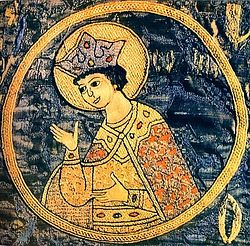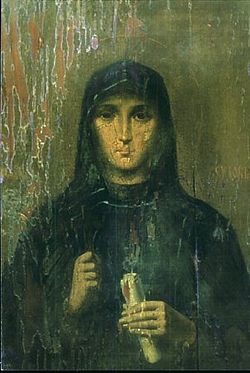
|
| St. Eudocia-Euphrosyne of Moscow. Embroidery detail from a hierarchical vestment. Novgorod. |
In view of Moscow's ascendancy as leader of Russia, it was a favorable marriage, but the young princess was not to be envied. These were turbulent times for the grand duchy, as one crisis spilled into another: Moscow was swept by a plague, ravaged by fire, besieged by the Lithuanians, engaged in a protracted war with Tver, and constantly at the mercy of the Tartars. In 1380 Grand Duke Dimitry gained a victory over the Tartar khan Mamai in a famous battle on the Kulikovo plain near the Don (for which he came to be known as "Donskoi"), but the Russian losses were staggering, and two years later Moscow was unable to adequately defend itself against Mamai's rival, the khan Tokhtamysh, who plundered the city, then set it afire, taking hostage the Grand Prince's eldest son, Basil.
Throughout all of these tragedies, Eudocia shone forth as a selfless laborer for the good of the people. When widows and orphans were left homeless by plague, fire and war, Eudocia relieved their plight in any way she could. Besides her personal care for the sick and her alms to the homeless, she prayed fervently for all the suffering people day and night.
The couple had not lived more than five year together when Dimitry was forced to go to the Horde in connection with a disagreement with Prince Michael Alexandrovich of Tver. (1399). He was blessed for this mission by St. Alexei of Moscow and St. Sergius of Radonezh, who also had a strong connection with this righteous couple. Dimitry would return safely to Moscow by their prayers, with the title of Grand Prince.
The pair lived their whole life under the spiritual care and guidance of these saints. St. Theodore, Abbot of Simonov Monastery in Moscow (later Archbishop of Rostov) was Eudocia’s spiritual father, and St. Sergius baptized Dimitry himself, and later two of his children, the first of whom, Basil, would ascend the throne after Dimitry’s death. It was written of Dimitry and Eudocia that they were of one spirit, and of one and the same virtuous life, their gaze always directed heavenward. The couple had in all five sons and three daughters.
In 1386 the Great Prince again had to depart for the fateful battle of Kulikovo, to free Rus’ from the Mongol-Tatar yoke. This was the famous battle blessed by St. Sergius of Radonezh, which ultimately led to freedom. Eudocia shared in this labor through her prayers and care for her people. In honor of this victory, she built a church dedicated to the Nativity of the Mother of God, which was frescoed by the famous iconographers, St. Maximos the Greek, and Symeon the Black. Dimitry earned the title “Donskoi” or “of the Don” for this battle, which took place near the Don River.
That victory, however, brought the wrath of the Tatar prince, Tokhtamysh upon Moscow. While the Grand Prince was gathering forces in Peryeslavl and Kostroma, leaving Eudocia to reign, Tokhtamysh razed the city and put much of Russia to the torch. Dimitry’s sorrow was boundless; he buried the dead using his own means. Tokhtamysh would later take thirteen-year-old Basil Dimitrievich captive for two years, during which Dimitry died from wounds he had received at Kulikovo. This was his fortieth year, 1389.
The throne passed to Basil, but Dimitry requested that the Grand Duchess refrain from entering a convent that she might take an active part in state affairs. Nevertheless, she lived a life of strict asceticism, establishing in the palace a convent dedicated to the Ascension. It was among the first to benefit from a new typicon (rule) drawn up by Metropolitan Alexis. Up until that time women's monastic communities were virtual dependencies of men's monasteries, submitting to their abbots and often separated from the men's communities only by a wall. Under the new typicon, which was eventually ratified by the Church Council of 1551, the convents were independent; their spiritual and administrative authority rested with the abbesses.
Her sons were still quite young and she began ruling as their regent, in cooperation with the boyars. Dressed in court finery, as her position required, she participated in their councils and banquets. Fired by envy or other passions, slander began circulating around her and reached her sons, who dared repeat this to their mother. She then opened her garments to reveal to them her chest, and they saw her body emaciated by fasting and weighed down by heavy chains. Profoundly moved, they threw themselves at her feet with tears, begging her forgiveness. She said to them simply, "Children, never trust outward appearances!" All her ascetic labors, her prayers and works of charity, the Grand Duchess concealed from human eyes.
The name of Grand Duchess Eudocia is connected with one of the most significant events in the spiritual history of Russia. It happened during the advance of Tamerlane in 1395 on Moscow. Having heard that army had reached the borders of Rus’, the people were in a panic. Thanks to his mother’s encouragement, Grand Prince Basil showed great strength of spirit, and gathered an army to meet the enemy. But this army was much too small to deal with Tamerlane’s invincible forces, intent upon conquering the world.
The people gathered in faith with their Grand Duchess and prayed to God with great fervency. At his mother’s advice, Basil commanded that the miracle-working Vladimir icon of the Mother of God be brought to Moscow from Vladimir. On August 26, 1395, Eudocia, together with her sons, Metropolitan Cyprian of Moscow, the clergy, boyars, and multitudes of the faithful went to meet the icon at Kuchkovo field. (Sretensky Monastery was later erected on this field as a memorial to that meeting.)
On that same day and hour, Tamerlane saw in a dream a “Radiant Lady” surrounded by light and a host of “warriors bearing lightening,” advancing upon him. His advisors suggested that he turn back from Rus’, which he did.
Before Euphrosyne died, an angel appeared and informed her that her earthly sojourn was nearing its end. She became mute and with gestures made it known that she wanted an icon painted of an angel. When the icon was finished she venerated it, but asked that another be painted. It was the same with the second icon. Only when an icon of Archangel Michael was painted did she recognize it to be the angel who appeared to her, and her speech returned.
 |
| St. Euphrosyne of Moscow |
A month after she entered the convent, the saint reposed. She had been tonsured with the name Euphrosyne (Evfrosinia) which means “joy” in Greek, on May 17, 1407. According to tradition, thirty people were healed that day from their various diseases. She departed to the Lord in the fifty-fourth year of her life, on July 7, 1407. She was buried at her own request in the church which she had begun to build, dedicated to the Ascension of Christ, in the Kremlin. Her miracle-working relics remained there until 1929.
She had been buried under the floor of the church, with a grave-covering over it as adornment. In 1922, after the communist revolution, this covering was plundered by the state, while St. Euphrosyne’s relics remained in the stone grave beneath the floor. In 1929, the government decided to destroy the edifices of the Ascension Convent. Thanks to the efforts of museum workers, her relics were saved along with the remains of other royal personages interred there; although her relics have yet to be identified separately from the others. The remains were interred in the Archangels Cathedral.
In 2006, construction began of a church dedicated to St. Euphrosyne in Moscow. It is located on the site of Grand Prince Dimitry Donskoi’s palace. When completed, there are plans to translate her relics to this church.
Compiled by Pravoslavie.ru from “Saint Euphrosyne of Moscow,” Orthodox America, and other sources.
